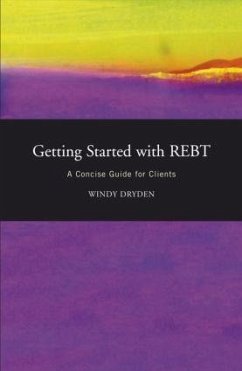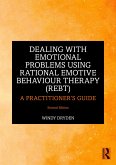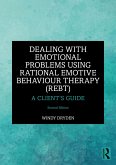Windy Dryden (Goldsmiths, University of London, UK)
Getting Started with REBT
A Concise Guide for Clients
28,99 €
inkl. MwSt.
Versandfertig in 1-2 Wochen

14 °P sammeln
Windy Dryden (Goldsmiths, University of London, UK)
Getting Started with REBT
A Concise Guide for Clients
- Broschiertes Buch
- Merkliste
- Auf die Merkliste
- Bewerten Bewerten
- Teilen
- Produkt teilen
- Produkterinnerung
- Produkterinnerung
Rational Emotive Behaviour Therapy encourages a healthier outlook by teaching individuals to challenge their irrational thoughts. This concise guide to REBT is suitable for use either alone or in conjunction with work with an REBT therapist
Andere Kunden interessierten sich auch für
![Rational Emotive Behavior Therapy in Sport and Exercise Rational Emotive Behavior Therapy in Sport and Exercise]() Rational Emotive Behavior Therapy in Sport and Exercise47,99 €
Rational Emotive Behavior Therapy in Sport and Exercise47,99 €![Dealing with Emotional Problems Using Rational Emotive Behaviour Therapy (REBT) Dealing with Emotional Problems Using Rational Emotive Behaviour Therapy (REBT)]() Windy DrydenDealing with Emotional Problems Using Rational Emotive Behaviour Therapy (REBT)29,99 €
Windy DrydenDealing with Emotional Problems Using Rational Emotive Behaviour Therapy (REBT)29,99 €![Dealing with Emotional Problems Using Rational Emotive Behaviour Therapy (REBT) Dealing with Emotional Problems Using Rational Emotive Behaviour Therapy (REBT)]() Windy DrydenDealing with Emotional Problems Using Rational Emotive Behaviour Therapy (REBT)24,99 €
Windy DrydenDealing with Emotional Problems Using Rational Emotive Behaviour Therapy (REBT)24,99 €![Working Creatively with Obstacles to Client Change in Rational Emotive Behaviour Therapy Working Creatively with Obstacles to Client Change in Rational Emotive Behaviour Therapy]() Windy Dryden (Goldsmiths, University of London, UK)Working Creatively with Obstacles to Client Change in Rational Emotive Behaviour Therapy42,99 €
Windy Dryden (Goldsmiths, University of London, UK)Working Creatively with Obstacles to Client Change in Rational Emotive Behaviour Therapy42,99 €![Good Practice in Rational Emotive Behaviour Therapy Good Practice in Rational Emotive Behaviour Therapy]() Windy Dryden (Goldsmiths, University of London, UK)Good Practice in Rational Emotive Behaviour Therapy42,99 €
Windy Dryden (Goldsmiths, University of London, UK)Good Practice in Rational Emotive Behaviour Therapy42,99 €![Rational Emotive Behaviour Therapy Rational Emotive Behaviour Therapy]() Windy Dryden (Goldsmiths, University of London, UK)Rational Emotive Behaviour Therapy35,99 €
Windy Dryden (Goldsmiths, University of London, UK)Rational Emotive Behaviour Therapy35,99 €![The Rational Practitioner The Rational Practitioner]() Martin TurnerThe Rational Practitioner35,99 €
Martin TurnerThe Rational Practitioner35,99 €-
-
-
Rational Emotive Behaviour Therapy encourages a healthier outlook by teaching individuals to challenge their irrational thoughts. This concise guide to REBT is suitable for use either alone or in conjunction with work with an REBT therapist
Hinweis: Dieser Artikel kann nur an eine deutsche Lieferadresse ausgeliefert werden.
Hinweis: Dieser Artikel kann nur an eine deutsche Lieferadresse ausgeliefert werden.
Produktdetails
- Produktdetails
- Verlag: Taylor & Francis Inc
- Seitenzahl: 136
- Erscheinungstermin: 26. Oktober 2006
- Englisch
- Abmessung: 198mm x 129mm x 8mm
- Gewicht: 160g
- ISBN-13: 9781583919392
- ISBN-10: 1583919392
- Artikelnr.: 21519435
- Herstellerkennzeichnung
- Libri GmbH
- Europaallee 1
- 36244 Bad Hersfeld
- gpsr@libri.de
- Verlag: Taylor & Francis Inc
- Seitenzahl: 136
- Erscheinungstermin: 26. Oktober 2006
- Englisch
- Abmessung: 198mm x 129mm x 8mm
- Gewicht: 160g
- ISBN-13: 9781583919392
- ISBN-10: 1583919392
- Artikelnr.: 21519435
- Herstellerkennzeichnung
- Libri GmbH
- Europaallee 1
- 36244 Bad Hersfeld
- gpsr@libri.de
Windy Dryden is an Emeritus Professor of Psychotherapeutic Studies at Goldsmiths University of London and is in part-time independent practice. His interests are in REBT, single-session therapy and very brief interventions and promoting self-help.Professor Dryden has written or edited over 280 books.
Introduction. Part I: Preparing You to Give Informed Consent. Part I.I: The
Theory of Rational Emotive Behaviour Therapy. How REBT Makes Sense of
Emotional Problems and the Healthy Alternatives to These Problems. The
Situational ABC Model. Characteristics of Irrational Beliefs and Rational
Beliefs. Demands versus Non-dogmatic Preferences. Awfulising Beliefs versus
Anti-awfulising Beliefs. Low Frustration Tolerance (LFT) Beliefs versus
High Frustration Tolerance (HFT) Beliefs. Depreciation Beliefs versus
Acceptance Beliefs. Part I.II: The Practice of Rational Emotive Behaviour
Therapy. REBT is Problem-focused. REBT is Goal-directed. REBT is Structured
and Logical in its Practice. REBT has an Educational Focus. REBT is
Primarily Present-centred and Future-oriented. REBT has a Skills Emphasis.
In REBT, the Therapist is Largely Active and Directive. The Process of
REBT. It's Decision Time. Part II: Dealing with Emotional Problems Using
REBT. Part II.I: Formulate Problems and Set Goals. Formulate Your Emotional
Problems. Set Goals. Part II.II: Assess Specific Examples of Your Emotional
Problems. Describe the Situation. Identify Your Disturbed Reactions at "C".
Identify Your "A". Identify Your Goals in the ABC. Identify Your Beliefs.
Review and the Importance of Practising Your ABCs. Identify any
Meta-emotional Problems. Part II.III: Question Your Irrational and Rational
Beliefs. Question Your Demands and Non-dogmatic Preferences. Question Your
Awfulising and Anti-awfulising Beliefs. Question Your Low Frustration
Tolerance (LFT) and High Frustration Tolerance (HFT) Beliefs. Question Your
Depreciation and Acceptance Beliefs. Variations on a Theme. The Importance
of Practising Your Disputing Skills. Part II.IV: Strengthen Your Conviction
in Your Rational Beliefs. Use the Attack-response Technique. Use
Rational-Emotive Imagery. Teach Rational Beliefs to Others. Use Rational
Self-statements. Rehearse Your Rational Beliefs While Acting and Thinking
in Ways that are Consistent with these Beliefs. Part II.V: Other Issues.
Reconsider "A". Identify and Deal with Core Irrational Beliefs. A Final
Note.
Theory of Rational Emotive Behaviour Therapy. How REBT Makes Sense of
Emotional Problems and the Healthy Alternatives to These Problems. The
Situational ABC Model. Characteristics of Irrational Beliefs and Rational
Beliefs. Demands versus Non-dogmatic Preferences. Awfulising Beliefs versus
Anti-awfulising Beliefs. Low Frustration Tolerance (LFT) Beliefs versus
High Frustration Tolerance (HFT) Beliefs. Depreciation Beliefs versus
Acceptance Beliefs. Part I.II: The Practice of Rational Emotive Behaviour
Therapy. REBT is Problem-focused. REBT is Goal-directed. REBT is Structured
and Logical in its Practice. REBT has an Educational Focus. REBT is
Primarily Present-centred and Future-oriented. REBT has a Skills Emphasis.
In REBT, the Therapist is Largely Active and Directive. The Process of
REBT. It's Decision Time. Part II: Dealing with Emotional Problems Using
REBT. Part II.I: Formulate Problems and Set Goals. Formulate Your Emotional
Problems. Set Goals. Part II.II: Assess Specific Examples of Your Emotional
Problems. Describe the Situation. Identify Your Disturbed Reactions at "C".
Identify Your "A". Identify Your Goals in the ABC. Identify Your Beliefs.
Review and the Importance of Practising Your ABCs. Identify any
Meta-emotional Problems. Part II.III: Question Your Irrational and Rational
Beliefs. Question Your Demands and Non-dogmatic Preferences. Question Your
Awfulising and Anti-awfulising Beliefs. Question Your Low Frustration
Tolerance (LFT) and High Frustration Tolerance (HFT) Beliefs. Question Your
Depreciation and Acceptance Beliefs. Variations on a Theme. The Importance
of Practising Your Disputing Skills. Part II.IV: Strengthen Your Conviction
in Your Rational Beliefs. Use the Attack-response Technique. Use
Rational-Emotive Imagery. Teach Rational Beliefs to Others. Use Rational
Self-statements. Rehearse Your Rational Beliefs While Acting and Thinking
in Ways that are Consistent with these Beliefs. Part II.V: Other Issues.
Reconsider "A". Identify and Deal with Core Irrational Beliefs. A Final
Note.
Introduction. Part I: Preparing You to Give Informed Consent. Part I.I: The
Theory of Rational Emotive Behaviour Therapy. How REBT Makes Sense of
Emotional Problems and the Healthy Alternatives to These Problems. The
Situational ABC Model. Characteristics of Irrational Beliefs and Rational
Beliefs. Demands versus Non-dogmatic Preferences. Awfulising Beliefs versus
Anti-awfulising Beliefs. Low Frustration Tolerance (LFT) Beliefs versus
High Frustration Tolerance (HFT) Beliefs. Depreciation Beliefs versus
Acceptance Beliefs. Part I.II: The Practice of Rational Emotive Behaviour
Therapy. REBT is Problem-focused. REBT is Goal-directed. REBT is Structured
and Logical in its Practice. REBT has an Educational Focus. REBT is
Primarily Present-centred and Future-oriented. REBT has a Skills Emphasis.
In REBT, the Therapist is Largely Active and Directive. The Process of
REBT. It's Decision Time. Part II: Dealing with Emotional Problems Using
REBT. Part II.I: Formulate Problems and Set Goals. Formulate Your Emotional
Problems. Set Goals. Part II.II: Assess Specific Examples of Your Emotional
Problems. Describe the Situation. Identify Your Disturbed Reactions at "C".
Identify Your "A". Identify Your Goals in the ABC. Identify Your Beliefs.
Review and the Importance of Practising Your ABCs. Identify any
Meta-emotional Problems. Part II.III: Question Your Irrational and Rational
Beliefs. Question Your Demands and Non-dogmatic Preferences. Question Your
Awfulising and Anti-awfulising Beliefs. Question Your Low Frustration
Tolerance (LFT) and High Frustration Tolerance (HFT) Beliefs. Question Your
Depreciation and Acceptance Beliefs. Variations on a Theme. The Importance
of Practising Your Disputing Skills. Part II.IV: Strengthen Your Conviction
in Your Rational Beliefs. Use the Attack-response Technique. Use
Rational-Emotive Imagery. Teach Rational Beliefs to Others. Use Rational
Self-statements. Rehearse Your Rational Beliefs While Acting and Thinking
in Ways that are Consistent with these Beliefs. Part II.V: Other Issues.
Reconsider "A". Identify and Deal with Core Irrational Beliefs. A Final
Note.
Theory of Rational Emotive Behaviour Therapy. How REBT Makes Sense of
Emotional Problems and the Healthy Alternatives to These Problems. The
Situational ABC Model. Characteristics of Irrational Beliefs and Rational
Beliefs. Demands versus Non-dogmatic Preferences. Awfulising Beliefs versus
Anti-awfulising Beliefs. Low Frustration Tolerance (LFT) Beliefs versus
High Frustration Tolerance (HFT) Beliefs. Depreciation Beliefs versus
Acceptance Beliefs. Part I.II: The Practice of Rational Emotive Behaviour
Therapy. REBT is Problem-focused. REBT is Goal-directed. REBT is Structured
and Logical in its Practice. REBT has an Educational Focus. REBT is
Primarily Present-centred and Future-oriented. REBT has a Skills Emphasis.
In REBT, the Therapist is Largely Active and Directive. The Process of
REBT. It's Decision Time. Part II: Dealing with Emotional Problems Using
REBT. Part II.I: Formulate Problems and Set Goals. Formulate Your Emotional
Problems. Set Goals. Part II.II: Assess Specific Examples of Your Emotional
Problems. Describe the Situation. Identify Your Disturbed Reactions at "C".
Identify Your "A". Identify Your Goals in the ABC. Identify Your Beliefs.
Review and the Importance of Practising Your ABCs. Identify any
Meta-emotional Problems. Part II.III: Question Your Irrational and Rational
Beliefs. Question Your Demands and Non-dogmatic Preferences. Question Your
Awfulising and Anti-awfulising Beliefs. Question Your Low Frustration
Tolerance (LFT) and High Frustration Tolerance (HFT) Beliefs. Question Your
Depreciation and Acceptance Beliefs. Variations on a Theme. The Importance
of Practising Your Disputing Skills. Part II.IV: Strengthen Your Conviction
in Your Rational Beliefs. Use the Attack-response Technique. Use
Rational-Emotive Imagery. Teach Rational Beliefs to Others. Use Rational
Self-statements. Rehearse Your Rational Beliefs While Acting and Thinking
in Ways that are Consistent with these Beliefs. Part II.V: Other Issues.
Reconsider "A". Identify and Deal with Core Irrational Beliefs. A Final
Note.








